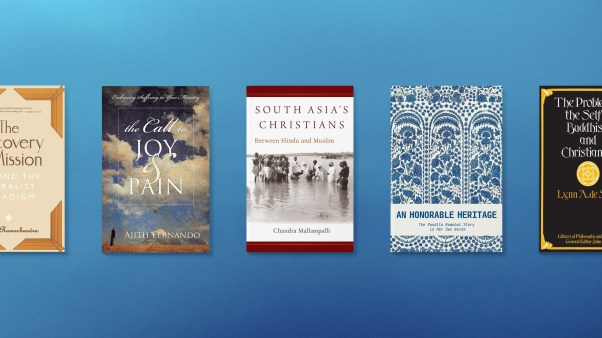How To Fix A Mainline
Can the historic denominations be saved? Tony Campolo thinks so.
CAN MAINLINE DENOMINATIONS MAKE A COMEBACK?by Tony Campolo (Judson, 205 pp.; $15, paper). Reviewed by Robert W. Patterson, a minister of the Presbyterian Church (U.S.A.) and writer in Cincinnati. He formerly served on the staff of the National Association of Evangelicals.
Growing up in the Philadelphia area has disadvantages, evangelically speaking, when compared to Chicagoland or Southern California; but whatever the City of Brotherly Love lacks is compensated for by the indefatigable Tony Campolo, the quintessential evangelical personality, who has been a dominant presence in the region since the early 1970s. Like many youngsters raised in the Delaware Valley, I vividly remember Tony, as he is affectionately known, passionately stirring crowds of teenagers into following Christ at the Tabernacle in the former Methodist camp meeting, Ocean City, New Jersey—not to mention his more intimate moments as retreat speaker for my church youth group.
Campolo’s knack for reaching young people with his Don Rickies looks and humor has not dissipated over the years, but in becoming a national figure, he has played more the role of a prophet, warning Christians about the seductions of the American dream, turning their affections to the plight of the poor, and relentlessly smashing the shibboleths of the evangelical subculture—but also shooting frequently from the hip on matters theological and otherwise. That has not always endeared him to other evangelical leaders. His 1983 book, A Reasonable Faith (Word), led Bill Bright of Campus Crusade abruptly to cancel Tony’s appearance at a 1985 youth rally in Washington, D.C., and to his summoning before an ad hoc “heresy trial” arranged by the Christian Legal Society, at which he was acquitted of heresy but reproved for carelessness in his theological statements.
So leave it to Tony Campolo to tackle a subject that few others in academia, the ministry, or the media are willing to challenge: the conclusion, shared by conservatives and liberals alike and supported by volumes of sociological and demographic data, that the mainline Protestant denominations are on their deathbed. As a sociologist and minister, Tony is well aware of the mainline blues, but he answers his question Can Mainline Denominations Make a Comeback? with a resounding yes, believing that the historic church bodies are on the verge of a dramatic revitalization. Using his own denomination, the American Baptist Churches in the U.S.A., as a case study, Tony concedes that a turnaround is not inevitable but suggests that if mainliners would just learn a few lessons from evangelicals, they could quickly return to the game as players in church and society.
By learning from evangelicals, Campolo does not mean adopting their message—especially not what he considers their conservative political baggage, with which the public, he alleges, is becoming increasingly disillusioned—but rather their method. He concedes that mainline churches for too long have ground a social ax at the expense of pastoral care and personal conversion. Unlike evangelicals, who have played the television age, the “culture of narcissism,” and the “culture wars” to their advantage, Campolo believes the mainline suffers from cultural lag, not being “structured to meet and relate to the kind of people whose consciousness and needs have been molded by social forces that have been playing themselves out since the beginning of the 1960s.”
The changes Campolo proposes are varied. He calls for downsizing of national denominational staffs, including the near elimination of programming bureaucracies; Christian education and youth ministry, he says, are far better served through the independent evangelical publishing houses and parachurch ministries like Young Life and InterVarsity. The sagging fortunes of denominational mission forces, he adds, might be revived through adopting the deputation system used by evangelical faith missions or a more selective earmarking of mission funds and causes at the local or regional level.
Some of his proposals appear to work against each other. Impressed with the lights shining on megachurches like Willow Creek Community Church in suburban Chicago, he calls for mainline leaders to follow suit, while simultaneously he calls for the development of house churches and discourages the construction of new church buildings. He urges his denomination to recruit the best and brightest for pastoral leadership, training them at one central megaseminary formed through a consolidation of several regional seminaries; yet, at the same time, he proposes lowering of ordination standards for minorities. To lessen tensions within pluralistic church bodies, he suggests a creative, although not altogether new, solution: a realignment of denominations where, for example, conservative American Baptist congregations would switch to Southern Baptist affiliation, and liberal Southern Baptists would switch to American Baptist, so that denominations would actually reflect shared commitments and values. At the same time, however, he seeks greater freedom and autonomy for congregations within denominations to deliberate on issues such as homosexuality and abortion.
Such unresolved contradictions may suggest that Campolo is just beginning to evaluate the issues, but they may also reflect the ambiguity that has haunted his thought over the years. Every bit as reflective of the Religious Left as Ralph Reed is of the Religious Right, Tony is a Mario Cuomo when it comes to what he calls the “hot issues.” Conceding that homosexuality is “contrary to what is normative in nature,” he then argues that churches have the right to receive homosexuals into full communion and even ordain them to the ministry. Whether he means repentant or proud homosexuals is not clear, either; when he refers to “the kind of homosexual acts that the Bible forbids,” does he intend to suggest there are some homosexual acts that the Bible does not forbid? The same evasiveness characterizes his discussion of abortion.
But the fatal flaw of Can Mainline Denominations Make a Comeback? is the author’s blind spot regarding the theological nature of the mainline problem. Because many individual American Baptist congregations have pastors who preach the Word faithfully to members who are solid evangelicals, Campolo assumes that the crisis in his denomination (and throughout the mainline) is not theological. Here he could have profited from the insights of another mainline minister, the Presbyterian John Leith, who identifies the root problem as “the loss of theological integrity and competence in the church’s witness,” or what he calls at a more basic level “a crisis of faith.” While Leith’s assessment does not apply to every mainline congregation, it clearly describes the systems that run the denominations and project their corporate witness.
Lacking this kind of theological analysis, Campolo ends up sounding like an influential Baptist of an earlier age, Harry Emerson Fosdick, who, relying heavily on sociology for guiding church life, called for greater tolerance and understanding between fundamentalists and liberals. While Fosdick had his way and the fundamentalists did not win, historians and theologians today are concluding that the Presbyterians’ failure to enforce theological commitments of church officers in the 1920s was the beginning of the end. Liberals ever since have loved talking out of both sides of their mouths. Now they are wondering why their denominations are turning into holding companies of historic buildings and half-filled sanctuaries.
Perhaps Campolo is too close to the problem to render objective judgment. Like a fossil from the 1960s, he clings to the liberal dream that has been discredited by the Reagan years, the fall of the Berlin Wall, the Persian Gulf War, Richard John Neuhaus, Rush Limbaugh, Forrest Gump, and the 1994 elections. Consequently, he at times advances what First Things calls the Mainline Tale, interpreting declining numbers as a cost of “faithfulness.” Seemingly oblivious to the disasters of ecclesiastical gifts to the Communist party in the 1960s or feminist excesses in the 1990s, Campolo boldly proclaims “that history will attest to the fact that mainline churches did not ‘play chicken’ at a crucial time in American history.”
Despite his limitations, Tony Campolo deserves praise for seeking to influence a smaller community, like his own denomination, before influencing a larger community, like a nation. Not allowing declining memberships to obscure the strategic institutional, financial, and historical resources of the mainline churches, he has, unlike many evangelical leaders, directed his ministry and this book not simply to an abstract “evangelical community” but to a concrete reality, the structures and institutions of a national denomination. Notwithstanding the evangelical leaders who were unjustly thrown out of the mainline denominations, one wonders what would have happened had those who remained adopted, not a popular strategy of winning a nation, but a more focused, institutional strategy, as did conservative Southern Baptists in the 1980s. Maybe then Can Mainline Denominations Make a Comeback? would have enjoyed a wider hearing and seemed less like a rhetorical question.
Bonhoeffer In Love
Letters from 1943 to 1945 between the theologian and his fiancée reveal the other half of a costly discipleship
LOVE LETTERS FROM CELL 92,edited by Ruth-Alice von Bismarck and Ulrich Kabitz (Abingdon, 368 pp.; $24.95, hardcover). Reviewed by Wendy Murray Zoba.
Wait with me, I beg you! Let me embrace you long and tenderly, let me kiss you and love you and stroke the sorrow from your brow. No, this is not an excerpt from a Harlequin romance. These are the impassioned longings of the champion of radical discipleship himself, Dietrich Bonhoeffer, as he wrote from a Nazi prison camp to his young fiancée, Maria von Wedemeyer.
These sentiments—and more like them—written during his imprisonment from 1943 to 1945 present a new aspect of Bonhoeffer, showing him to be surprisingly amorous, but in a way altogether consistent with his theology of costly grace. Such love for Maria was “costly” because Bonhoeffer was forced to relinquish it; it was “grace,” because after 37 years of heady bachelorhood, he tasted of the wellspring of romantic possibility.
Maria von Wedemeyer has been duly acknowledged as the true love of the gifted German theologian. But never before have Bonhoeffer’s devotees been given such a glimpse of the force of this relationship and the passion this man felt, and sublimated, during his hard years in prison.
He loved her, longed for her, and she for him. And the tenderness and optimism behind this collection of letters is what drives the book. The reader languishes with them as week after week, unto months, unto years, the couple anticipates the time when they will sit together on the couch at Pätzig (Maria’s family estate) and hold hands. The reader also knows the tragic ending to this tale, while the writers themselves do not. A constant theme echoes throughout: “Don’t get tired and depressed, my dearest Dietrich, it won’t be much longer now.”
Maria entrusted this collection of letters to her sister, Ruth-Alice von Bismarck, just prior to her death in 1977. For years before that, Maria would not allow the letters to be published. Eberhard Bethge, Bonhoeffer’s close friend and biographer, writes in the postscript: “I had resigned myself to never seeing this correspondence.”
It took the subsequent 15 years for von Bismarck to complete the task of sequentially collating the correspondence (and supplemental diary entries), with the aid of Ulrich Kabitz, who added the necessary footnotes and historical data. Consolidating such fragmented, at times incomplete, material into a coherent narrative was no simple task. But, overall, it works: the reader is pulled right into the drama and tedium that these two lovers experienced during their years of waiting and hoping.
One of the most refreshing dimensions of this book is the marvelous picture it paints of Maria, a personality quite distinct and in many ways contradictory to Bonhoeffer’s. She took great interest in the minutiae of bourgeois trivialities—“I hate sideboards, and really decent cupboards are quite unobtainable”—while church missionary meetings bored her to tears. For that matter, she had little patience for theology: “Theology strikes me as an incomprehensible discipline.… I always get the feeling that it’s seeking an intellectual explanation for what is quite simply a question of faith.” (She adds at the end of that letter: “you mustn’t think I disapprove of your work.”) One is tempted to wonder how the champion of single-minded obedience could have fallen for a woman whose priorities were so different from his own.
But the reader is stopped short. Woven into the narrative are glimpses of Maria that betray an extraordinary resolve, discipline, and effervescence. Within the course of only a few months in 1942, Maria lost both her father and her brother in the war. Still, she kept her spirits up for Bonhoeffer’s sake. For his first Christmas in prison, she brought a formidable Christmas tree for his cell, creating “great hilarity with the guards and Dietrich.” She tirelessly addressed Bonhoeffer’s every conceivable want or need: “In front of me, lit by your candles,” he wrote to her, “stands the little Madonna you gave me.… Behind it are the open texts with the ‘praying hands’ [you gave me] … on their right, your photos lying open in the case you made for me. Just above them hangs your Advent wreath, and behind me on the edge of the bed I’ve laid out the gloves you made for me, the books you chose for me.… On my wrist is the watch [your] Father was wearing when he died, which you gave me, brought me, and strapped on my wrist yourself. You’re all around me, Maria.”
Over time, their correspondence became more tortured. Hope faded. But a fellow prisoner recalled that Bonhoeffer “never tired of repeating that ‘no battle is lost until it has been given up for lost.’ ”
After his death, Maria moved to the United States, where she carved out a successful career in mathematics and computer technology. She also married and divorced, twice. One wonders what would have become of her marriage to Bonhoeffer.
But it is a moot point. This book is about a love that was never to be fulfilled, adding color and depth to our picture of Bonhoeffer. Maria’s hand, like everything else in his short life, remained just beyond his reach. Even so, he could write to her: “Above all let us be careful not to feel sorry for ourselves; to do so would truly be a blasphemy on God, who means us well. For all our difficulties, let us say with Isaiah: ‘Do not destroy it, for there is blessing in it.’ ”










